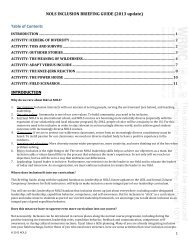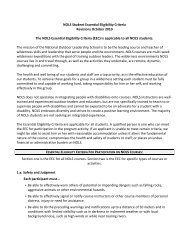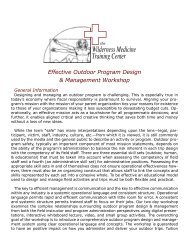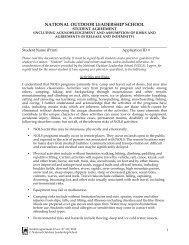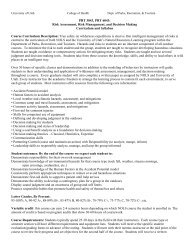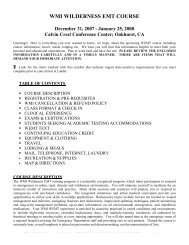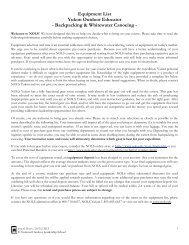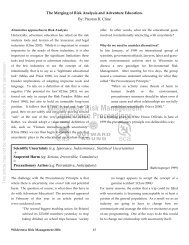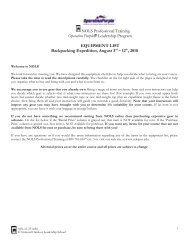comfort. Overall, <strong>the</strong> atmosphere is supportive, energetic and open.The <strong>leadership</strong> norm is peers guiding and coaching <strong>the</strong>ir peers.But beware: Stewardship takes lots of effort on <strong>the</strong> part of <strong>the</strong>instruc<strong>to</strong>rs and <strong>the</strong> group. Some people may not buy in<strong>to</strong> it. In<strong>the</strong> time span of a regular course, it is not likely <strong>to</strong> work perfectly,particularly if <strong>the</strong>re is a wide range of maturity levels in <strong>the</strong> group. Itcan be held as a vision more than something we believe we can arriveat easily. Most courses use large aspects of this model and semestersare able <strong>to</strong> take it fur<strong>the</strong>r still, often with excellent results.Peer expeditions have tried this model with various degrees ofsuccess. It works well in easy times and with well-bonded, maturegroups, less well in stressful times if <strong>the</strong> group doesn’t take <strong>the</strong> time<strong>to</strong> collaborate. Collaboration means taking time <strong>to</strong> discuss all <strong>the</strong>pros and cons and listen <strong>to</strong> o<strong>the</strong>r viewpoints. People venture in<strong>to</strong>trips or situations thinking <strong>the</strong>y are using this model, when actually<strong>the</strong>y have entered in<strong>to</strong> <strong>leadership</strong> abdication and laissez-faire, or, allpeople aren’t speaking up honestly and so only a few are actuallyrunning <strong>the</strong> expedition.DIMENSIONS OF LEADERSHIPAll leaders exhibit some of <strong>the</strong> behaviors encompassed in <strong>the</strong>sefour dimensions:• Being Au<strong>the</strong>ntic• Respecting• Conceptualizing• DirectingBreaking down <strong>leadership</strong> behavior in<strong>to</strong> <strong>the</strong>se four categoriesmay help you coach a student who is performing better in someareas than o<strong>the</strong>rs.Being Au<strong>the</strong>ntic occurs when you share what is going on foryou—in <strong>the</strong> moment—as it pertains <strong>to</strong> your current experience in<strong>the</strong> group. This is <strong>leadership</strong> through being open and honest aboutwhat you think, feel and want.Examples:1) “I am really frustrated that people keep carrying on side conversationsduring our classes.”2) fnigle“I’m frustrated that only two of <strong>the</strong> five members of thishiking group are reading <strong>the</strong> map. I want <strong>to</strong> hear input fromeveryone.”Too much or <strong>to</strong>o little “au<strong>the</strong>nticity”:• If I hide who I am and what I believe, <strong>the</strong>n people around memiss much of what I have <strong>to</strong> offer.• If I am so ‘loud’ with my beliefs and personal presence it leaveslittle room for o<strong>the</strong>rs <strong>to</strong> share <strong>the</strong>ir <strong>leadership</strong>.• I am most effective when I share who I am and what I believewhile still leaving room for o<strong>the</strong>rs <strong>to</strong> express <strong>the</strong>mselves.Group Outcomehighmediumlowlow medium highdegree of AUTHENTICbehavior expressedCoaching on Au<strong>the</strong>nticityUse direct feedback with specific examples of when you have seen<strong>the</strong> student be au<strong>the</strong>ntic or inau<strong>the</strong>ntic with o<strong>the</strong>rs.Discuss self-<strong>leadership</strong> and self-awareness as ways of working on<strong>leadership</strong>, even one is not in an LOD role.Respecting is just like it sounds. It occurs when you offer friendship,affection, support, praise and encouragement. Respectful leadersexpress warmth, acceptance, genuineness and a real concern forus. Respecting is about caring and supporting. This isn’t limited <strong>to</strong>being “warm and fuzzy”—genuine respecting can be conveyed ina “<strong>to</strong>ugh love” style. Simply put, this is <strong>leadership</strong> through beingsupportive, treating o<strong>the</strong>rs with respect, and showing people youbelieve in <strong>the</strong>m.Example: “Alan, you seem down about your efforts as leader of<strong>the</strong> day. I want you <strong>to</strong> know that I respect your efforts. I trust in yourability <strong>to</strong> turn <strong>the</strong>se lessons in<strong>to</strong> future success.” In general <strong>the</strong> morerespecting is done by <strong>the</strong> leader, <strong>the</strong> better <strong>the</strong> group outcome.Group Outcomehighmediumlowlow medium highdegree of RESPECTINGbehavior expressedCoaching on RespectVisualize a leader or men<strong>to</strong>r who has had a positive impact on yourlife. Now ask yourself, “Did I feel respected by this individual?”Think of some different ways this person conveyed <strong>the</strong>ir respectfor you or for your potential, like trusting you <strong>to</strong> hear critical feedbackor letting you make a mistake and <strong>the</strong>n supporting your learning.Conceptualizing describes <strong>the</strong> skill of helping <strong>the</strong> group makesense of behaviors, group dynamics and events that effect <strong>the</strong> group.This includes knowing <strong>the</strong> how’s and why’s of individual and groupbehavior, and helping people understand <strong>the</strong>ir current situationfrom a new angle. Have you ever seen a leader who could help agroup see <strong>the</strong> “big picture” when <strong>the</strong>y are stuck? Such leaders helppeople reconstruct <strong>the</strong>ir understanding of what is going on. Perhaps<strong>the</strong>y pointed out that conflict is “normal” and expected during <strong>the</strong>s<strong>to</strong>rming phrase of group development. When done well, you canalmost see <strong>the</strong> light bulbs light up over people’s heads, <strong>the</strong> proverbial,“Oh, now I get it!” Conceptualizing helps people make senseout of <strong>the</strong>ir experiences.Example: “I’m noticing that <strong>the</strong> group keeps rehashing this sameissue in every evening meeting. Perhaps that is because we are allpeers and it isn’t clear who should make this decision.”Coaching ConceptualizationOutline basic tasks so your students can understand <strong>the</strong> variousparts and how <strong>the</strong>y all fit <strong>to</strong>ge<strong>the</strong>r.Explain why <strong>the</strong> safety rules exist. Help students <strong>to</strong> create genericparameters for applying <strong>the</strong> concepts <strong>to</strong> o<strong>the</strong>r wilderness situations.Coach students on subtle improvements, leading <strong>the</strong>m <strong>to</strong> a deeperunderstanding of <strong>leadership</strong> skills and behaviors.Defining Leadership 14<strong>2008</strong> NOLS Leadership Educa<strong>to</strong>r Notebook
Group OutcomeTeach conceptual level classes on <strong>to</strong>pics like team dynamics and<strong>leadership</strong> in addition <strong>to</strong> technical skills.Directing is providing <strong>the</strong> more traditional functions of executive<strong>leadership</strong>. This is <strong>leadership</strong> through actively structuring a group,by setting group rules, creating norms for behavior, setting goals,managing time and <strong>the</strong> like. When directing, leaders ei<strong>the</strong>r prescribespecific actions, or <strong>the</strong>y s<strong>to</strong>p specific actions and focus on particularbehaviors or events. In directing mode, you might s<strong>to</strong>p <strong>the</strong> groupand suggest <strong>the</strong>y reflect on something that just happened. Comparethis with conceptualizing, where you might also s<strong>to</strong>p <strong>the</strong> group andfocus on an event, but you would likely add your interpretation of<strong>the</strong> event. Directing includes organizing, questioning and choreographingkey events.Example: “Before we start our break, let’s decide how long wewant it <strong>to</strong> be.” Generally groups respond best <strong>to</strong> moderate amountsof directing behavior.Coaching on DirectingHelp students identify situations when <strong>the</strong>y have felt <strong>the</strong>re was<strong>to</strong>o little directing being done by <strong>the</strong> leader, and what <strong>the</strong> consequencesof this were. Then ask <strong>the</strong>m <strong>to</strong> reflect on situations with <strong>to</strong>omuch directing being and what happened.Ask students <strong>to</strong> identify cues which help <strong>the</strong>m know <strong>the</strong>y are doing<strong>the</strong> “right” amount of directing.Acknowledge that <strong>the</strong> optimal amount of directing varies—itchanges as <strong>the</strong> group and <strong>the</strong> situation change!There are an infinite number of different aspects of <strong>leadership</strong> youcan coach students on! These are just four <strong>to</strong> help get you started.Group Outcomehighmediumlowhighmediumlowlow medium highdegree of CONCEPTUALIZINGbehavior expressedlow medium highdegree of DIRECTINGbehavior expressedSELF-DIFFERENTIATED LEADERSHIPThis is <strong>the</strong> idea that real <strong>leadership</strong> comes about when you begin<strong>to</strong> view yourself and your followers as a system that functions aspart of one ano<strong>the</strong>r. The <strong>the</strong>ory of self-differentiated <strong>leadership</strong> isall about what makes someone a mature, special leader. Being yourau<strong>the</strong>ntic self is what matters: this means your actions are alignedwith your values.Well-differentiated, emotionally mature individuals, who bringa lot of “self” <strong>to</strong> any relationship we call “self-differentiated”. Thesepeople are comfortable being who <strong>the</strong>y are and saying or doing what<strong>the</strong>y think <strong>the</strong>y need <strong>to</strong> say or do in any relationship. Highly selfdifferentiatedleaders maintain a good level of emotional calm evenwhen people are disagreeing with <strong>the</strong>m or resisting <strong>the</strong>ir ideas. Theykeep things in perspective, seeing both paradox and humor in <strong>the</strong>mselvesand life. They can be very emotional—but <strong>the</strong>y have morechoice about it. People generally have better, more truly connectedrelationships, make better choices and are more effective leaderswhen <strong>the</strong>y have greater self-differentiation (Kerr, 1988).Self-differentiated individuals are inter-dependant, not isolatedand independent. It is arguable that students need high self-differentiation<strong>to</strong> be able <strong>to</strong> lead <strong>the</strong>ir friends on extended camping trips.At most, we may only get students <strong>to</strong> understand <strong>the</strong>ir ability <strong>to</strong>state what <strong>the</strong>y think, feel and want and <strong>the</strong>ir ability <strong>to</strong> stay connectedand seek input from <strong>the</strong>ir group.Chapter II References and Resources• Bennis, W. (1995). On Becoming a Leader. NY: Addison-Wesley.• Blanchard, K. (1999). Leadership and <strong>the</strong> one minute manager.• Block, P. (1993). Stewardship. SF, CA: Berrett-Koehler.• Deluga, R. J. (1992). The Relationship of Leader-Member Exchangeswith Laissez-Faire, Transformational and TransactionalLeadership on Naval Environments. Impact of Leadership. NorthCarolina, Center for Creative Leadership.• French, J., Jr., and Raven, B. (1959). The Bases of Social Power.In D. Cartwright (Ed.), Studies in Social Power. Ann Arbor, MI:Institute for Social Research.• Friedman, E.H. (1985). Generation <strong>to</strong> Generation. NY: Guilford.• Hersey, P. and Blanchard, K. H. (1963). Organizational Behavior.(6th ed.). Englewood Cliffs, NJ: Prentice-Hall.• Hesselbein, F., Goldsmith, M., & Beckhard, R., (1996). Leaderof <strong>the</strong> Future. San Francisco, CA: Jossey-Bass.• Johnson, D., & Johnson, F. (1987). Joining Toge<strong>the</strong>r: Group Theoryand Group Skills. Englewood Cliffs, NJ: Allyn & Bacon.• Kerr, M and Bowen, M. (1988). Family Evaluation. New York,NY: W.W. Nor<strong>to</strong>n and Company, Inc.• Lieberman, M., Yalom, I., & Miles, M. (1973). Encounter Groups:First Facts. Basic Books.• Schultz, W. (1975). Not Encounter and Certainly Not Facts. Journalof Humanistic Psychology, 7-18.• Senge, P. (1994). The Fifth Discipline. NY, NY: Currency andDoubleday.• Short, R. (1991). A Special Kind of Leadership. Seattle, WA: TheLeadership Group.• S<strong>to</strong>gill R. (1974). Handbook of Leadership. NY, NY: Free Press.• Yalom, I. (1975). How effective is <strong>the</strong> encounter group? The Theoryand Practice of Group Psycho<strong>the</strong>rapy, (2nd ed.), 471-478.<strong>2008</strong> NOLS Leadership Educa<strong>to</strong>r Notebook 15Defining Leadership




